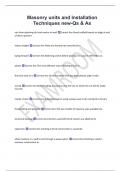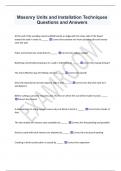Masonry units - Study guides, Class notes & Summaries
Looking for the best study guides, study notes and summaries about Masonry units? On this page you'll find 373 study documents about Masonry units.
Page 2 out of 373 results
Sort by

-
CP-FS Practice Test 7,8,10 with 100% correct answers
- Exam (elaborations) • 27 pages • 2023
-
Available in package deal
-
- $15.49
- 1x sold
- + learn more
What occurs when a pathogen grows within the body? 1. Food intoxication. 2. Fungal contamination. 3. Parasite. 4. Food infection. 4 Food infection and food intoxication develop in different ways. Food infection occurs when the pathogen develops within the body. Hepatitis A is an example of an infection. An employee has nasal discharge. What is the appropriate response? 1. Exclude the employee from the premises. 2. Send the employee to the doctor. 3. Monitor the employee to make s...
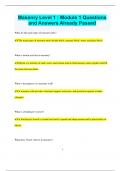
-
Masonry Level 1 : Module 1 Questions and Answers Already Passed
- Exam (elaborations) • 16 pages • 2024
- Available in package deal
-
- $9.99
- + learn more
Masonry Level 1 : Module 1 Questions and Answers Already Passed What are the main types of masonry units? The main types of masonry units include brick, concrete block, stone, and glass block. What is mortar used for in masonry? Mortar is a mixture of sand, water, and cement used to bind masonry units together and fill the joints between them. What is the purpose of a masonry wall? A masonry wall provides structural support, enclosure, and protection against weather elements. ...
Masonry units and Installation Techniques new-Qs & As
Masonry Units and Installation Techniques Questions and Answers

-
Illinois Lead Risk Assessor Guide – 2022/2023 Already Passed
- Exam (elaborations) • 15 pages • 2023
- Available in package deal
-
- $9.99
- 1x sold
- + learn more
Illinois Lead Risk Assessor Guide – 2022/2023 Already Passed Water Lead Action Level 5 ppb Soil High Contact Area Action Level 400 ppm Soil General Action Level 1200 ppm Soil Abatement Level 5000 ppm Soil IDPH Regulatory Level 1000 ppm Paint Chip - HUD hazard level 5000 ppm or 0.5% Lead by weight Consumer Product Safety Commission (CPSC) - Regarding Lead Banned new paint containing more than 90 ppm (or 0.009%) lead for residential use. T/F: There is a ban for LBP in an industrial settin...
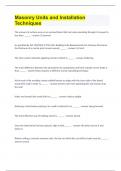
-
Masonry Units and Installation Techniques
- Exam (elaborations) • 2 pages • 2023
- Available in package deal
-
- $13.99
- + learn more
The amount of surface area on an uncored block that has holes extending through it is equal to less than _____. 25 percent As specified by ACI 530/ASCE 5/TMS 402, Building Code Requirements for Masonry Structures, the thickness of a mortar joint cannot exceed _____. 3/4 inch The term used to describe applying mortar to block is _____. buttering The main difference between the procedures for laying block and brick outside-corner leads is that _____. block requires a diffe...
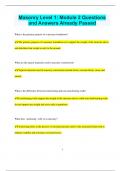
-
Masonry Level 1: Module 2 Questions and Answers Already Passed
- Exam (elaborations) • 15 pages • 2024
- Available in package deal
-
- $9.99
- + learn more
Masonry Level 1: Module 2 Questions and Answers Already Passed What is the primary purpose of a masonry foundation? The primary purpose of a masonry foundation is to support the weight of the structure above and distribute that weight evenly to the ground. What are the typical materials used in masonry construction? Typical materials used in masonry construction include brick, concrete block, stone, and mortar. What is the difference between load-bearing and non-load-bearing walls?...
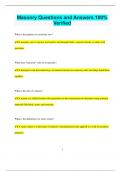
-
Masonry Questions and Answers 100% Verified
- Exam (elaborations) • 23 pages • 2024
- Available in package deal
-
- $9.99
- + learn more
Masonry Questions and Answers 100% Verified What is the purpose of a masonry saw? A masonry saw is a power tool used to cut through bricks, concrete blocks, or stone with precision. What does “bed joint” refer to in masonry? A bed joint is the horizontal layer of mortar between two masonry units that helps bond them together. What is the role of a mason? A mason is a skilled worker who specializes in the construction of structures using masonry materials like brick, stone...

-
Masonry Level One Module 28102-13 Exam Questions and Answers Already Passed
- Exam (elaborations) • 18 pages • 2024
- Available in package deal
-
- $9.99
- + learn more
Masonry Level One Module 28102-13 Exam Questions and Answers Already Passed What is the main ingredient in mortar? - A) Gravel - B) Sand - C) Water - D) Cement D) Cement Which type of brick is designed for load-bearing walls? - A) Firebrick - B) Common brick - C) Paving brick - D) Hollow brick B) Common brick What is the purpose of a bond beam in masonry construction? 2 - A) To provide insulation - B) To help distribute loads across walls - C) To improve the aest...
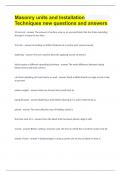
-
Masonry units and Installation Techniques new questions and answers
- Exam (elaborations) • 2 pages • 2023
- Available in package deal
-
- $14.49
- + learn more
25 percent The amount of surface area on an uncored block that has holes extending through it is equal to less than 3/4 inch According to ACIthe thickness of a mortar joint cannot exceed buttering The term used to describe applying mortar to block is block require a different spreading technique The main difference between laying block corners and brick corners rain from splashing dirt and mortar on wall Stand scaffold boards on edge at end of day to prevent ...

Study stress? For sellers on Stuvia, these are actually golden times. KA-CHING! Earn from your study resources too and start uploading now. Discover all about earning on Stuvia

